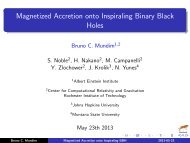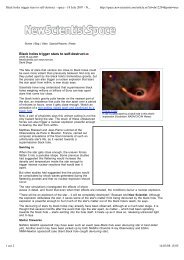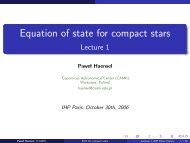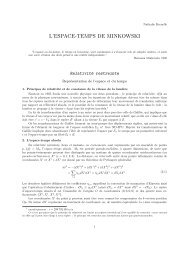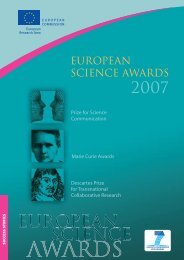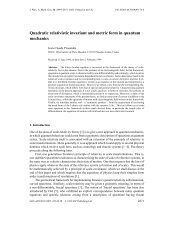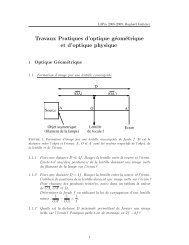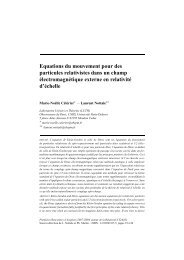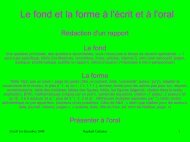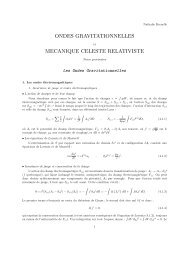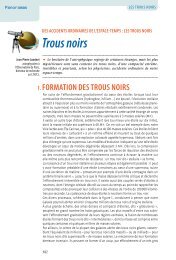An Introduction to Supernovae - LUTH
An Introduction to Supernovae - LUTH
An Introduction to Supernovae - LUTH
You also want an ePaper? Increase the reach of your titles
YUMPU automatically turns print PDFs into web optimized ePapers that Google loves.
<strong>An</strong> <strong>Introduction</strong><br />
<strong>to</strong><br />
<strong>Supernovae</strong><br />
Ewald Müller<br />
Max-Planck Institut für Astrophysik
E S O -V LT<br />
Crab nebula<br />
with pulsar<br />
(constellation<br />
Orion)<br />
Remnant of a<br />
supernova<br />
observed in<br />
the year 1054
A New Star, as bright and as red as<br />
Mars, was discovered on Oc<strong>to</strong>ber 9<br />
1604, close <strong>to</strong> the position where<br />
another astrologically significant event<br />
was taking place, the conjunction of<br />
Mars and Jupiter. The New Star created<br />
a stir throughout Europe.<br />
At Padua the new star was observed by<br />
Galileo, while in Prague Kepler made<br />
careful observations and the Supernova<br />
now carries his name.<br />
Galileo gave 3 public lectures that were<br />
attended by a large audience in which<br />
he demonstrated that the new star was<br />
much further than the moon.<br />
This had important astronomical<br />
consequences since it showed that<br />
change occurrs in the sky, contrary <strong>to</strong><br />
the theory of Aris<strong>to</strong>tle and his followers.
SN 1604 composite image:<br />
X-ray (Chandra, green-blue)<br />
optical (HST, yellow)<br />
IR (SST, red)<br />
Last observed galactic<br />
supernova!<br />
Note:<br />
first use of a telescope for<br />
astronomical purpose by<br />
Galileo Galilei in 1609!
C h a n d ra : X -ra y c o m p o s ite im a g e<br />
central X-ray<br />
point source<br />
found in 2000<br />
by Chandra: a<br />
neutron star?<br />
Cassiopeia A:<br />
Remnant of a supernova<br />
exploded around 1680<br />
X-ray images<br />
in different<br />
lines<br />
(Si, Ca & FeK)
Cas A composite image:<br />
X-ray (Chandra, green-blue), optical (HST, yellow) & IR (SST, red)
•<br />
• <strong>Supernovae</strong> in the Milky Way during the last millenium<br />
•<br />
• date visible for distance observed in/by<br />
• 1006 some years 6 500 far east, Arabia, St.Gallen<br />
• 1054 about 2 years 7 100 far east, Arabia<br />
• 1181 6 months 26 000 China, Japan<br />
• ~1300 ? 650 ? (RX J0852-4642)<br />
• 1572 16 months 23 000 Tycho Brahe<br />
• 1604 about 1 year 32 000 Johannes Kepler<br />
• ~1680 ? 11 000 Flamsted ? (Cas A)<br />
• 23.2.1987 >18 years 160 000 Ian Shel<strong>to</strong>n<br />
•<br />
1<br />
• Number of observed extragalactic supernovae: > 3100 (since 1885)
30 Doradus region in the Large Magellanic Cloud<br />
(d ~ 160 000 light years)<br />
-<br />
Blue Supergiant<br />
Sandulek 69.202<br />
Supernova 1987A<br />
7:35 UT 23.2.1987
-<br />
Supernova 1987A<br />
environment & ring system
Supernova 1987A: Blast wave encountering the inner ring<br />
-
angular size: ~ 8 o (ie. ~16 x size of moon)<br />
ROSAT X-ray<br />
image of<br />
Vela (d ~500pc)<br />
&<br />
Puppis (d~2kpc)<br />
SNR<br />
Age of Vela SNR<br />
~11000 yrs<br />
credit:<br />
Aschenbach et.al<br />
1995, Nature 373, 587
ROSAT X-ray observations at<br />
low energy & high energy<br />
reveal three (!) partially overlapping SNRs:<br />
Vela, Puppis A & Vela Jr. (RX J0852.0-4622)<br />
(Aschenbach 1998, Nature 396, 141)
credit:<br />
W.P.Blair<br />
(John Hopkins Univ.,<br />
Baltimore, USA)
ROSAT X-ray picture with<br />
labeled protrusions<br />
credit: Aschenbach et.al<br />
1995, Nature 373, 587<br />
CANDRA X-ray image of<br />
immediate neighbourhood<br />
of Vela pulsar<br />
(region would be barely visible<br />
on neigbouring ROSAT image!)
ESO-VLT: NGC 6118 & SN2004dk<br />
( d ~ 25 Mpc , Ib/c)
SN 1993J in M81: Evolution of the radio remnant (MERLIN)
SN 1993J in M81<br />
(d = 3.7 Mpc)<br />
Evolution of the radio<br />
remnant (MERLIN)<br />
* March 28, 1997<br />
red supergiant<br />
progeni<strong>to</strong>r identified<br />
(2 nd time in his<strong>to</strong>ry!)<br />
ejecta <strong>to</strong>o rich in He &<br />
bizarre light curve<br />
--> binary system?
INT, LaPalma<br />
HST WFPC2<br />
HST ACS/HRC<br />
Site of SN 1993J<br />
credit:<br />
ESA & J.R.Maund
Close-up of SN 1993J explosion site<br />
blue companion star<br />
discovered 10 years after<br />
explosion by HST<br />
light echo<br />
(credit: ESA & J.R.Maund)
SN 1993J exploding (artist's impression)<br />
[ credit: ESA & J.R.Maund ]
T y p e Ia s u p e rn o va a t z = 0.9 5
Supernova „botanics“ according <strong>to</strong> spectra & light curves
Supernova light curves<br />
pronounced maximum<br />
after 2-3 weeks<br />
exponential tail<br />
(radioactive decay of<br />
56 Ni 56 Co 56 Fe)<br />
maximum brightness<br />
largest for SNe Ia<br />
only SNe Ia form a (quite)<br />
homogeneous class<br />
standard candles!?<br />
possibility <strong>to</strong> measure<br />
expansion of universe
Supernova spectra<br />
discriminate types<br />
(no spectrum no type!!)<br />
provide information<br />
about<br />
- stellar & explosive<br />
nucleosynthesis<br />
- abundances and<br />
chemical stratification<br />
(<strong>to</strong>mography)<br />
- stellar environment &<br />
progeni<strong>to</strong>r star
Number of supernovae per year as function of survey distance<br />
Milky way: 2.4 supernovae/century (70% CCSN) (Arnaud etal '04)<br />
(none in Milky way since 1680 & none in <strong>An</strong>dromeda since 1885)
●<br />
● Observational facts<br />
● - very bright event: L ~ 10 10 L sun<br />
● - fast expanding ejecta: v ~ 10 4 km/s<br />
● - energies: electromagnetic: ~ 10 49 erg<br />
● kinetic: ~ 10 51 erg<br />
● neutrinos (SN1987A): ~ 3 10 53 erg (not SNe Ia)<br />
● - progeni<strong>to</strong>r star distroyed (SN 1987A, SN 1993J)<br />
● - freshly synthesized 56 Ni (0.07M sun in SN1987A;<br />
0.2 – 0.8 M sun in SNe Ia)<br />
● - neutron stars in (some) SNRs (not SNe Ia)<br />
● - neutron star kicks (up <strong>to</strong> 1000km/s !)
•<br />
• energy sources for a supernova explosion<br />
•<br />
• thermonuclear energy (SNe Ia)<br />
• conversion of ~1 solar mass of He, C or O in<strong>to</strong><br />
• iron group nuclei --><br />
•<br />
• gravitational binding energy (SNe II, Ib, Ic)<br />
• formation of a compact object of ~1 solar mass<br />
with a radius ~10km<br />
• --><br />
• E ~ 3 10 53 erg<br />
• E ~ 10 51 erg
Supernova classification according <strong>to</strong> physical processes
•<br />
•<br />
• Importance of <strong>Supernovae</strong>:<br />
• Universal players in“<br />
• - nucleosynthesis<br />
(we are star dust)<br />
1<br />
• - star formation<br />
(including the solar system)<br />
• - evolution of the ISM<br />
(energizing, mixing, ejection)<br />
• - production of cosmic rays<br />
(up <strong>to</strong> 30% of SN energy)
●<br />
●<br />
Si<br />
O<br />
Note: figure not drawn <strong>to</strong> scale!<br />
C<br />
He<br />
H<br />
Onion-like structure<br />
of a CCSN progeni<strong>to</strong>r<br />
several million years<br />
after its birth:<br />
mass: 10 ... 10 2 M sun<br />
radius: 50 ... 10 3 R sun<br />
- shells of different<br />
composition are<br />
separated by active<br />
thermonuclear<br />
burning shells<br />
- core Si-burning<br />
leads <strong>to</strong> formation<br />
of central iron core
•<br />
• Observational evidence for large scale mixing in SN 1987A<br />
1
Observational evidence for a globally anisotropic explosion<br />
●SN1987A:<br />
●ejecta are non-spherical<br />
●<br />
●(Wang et al. 2002)
Further evidence for non-spherical core collapse supernova explosions<br />
● indirect:<br />
● - large pulsar velocities<br />
- association with long GRBs<br />
- asymmetries in late-time emission-line profiles of SNe Ic<br />
● direct:<br />
● - spectropolarimetry of SNe Ic &<br />
● SNe II-P (SN2004dj, 3.1Mpc; Leonhard et al. '06)<br />
●<br />
●<br />
●<br />
●<br />
●<br />
●<br />
●<br />
●<br />
●<br />
●<br />
●<br />
●<br />
Vela SNR:<br />
protrusions, fast pulsar<br />
● progeni<strong>to</strong>r: super giant in compact star cluster (Sandage's star 96), ~12 M sol (Wang et al. '05)
Observing the<br />
Surface:<br />
CCSN length<br />
scale problem<br />
30 000 000 km<br />
15 km<br />
Blue Giant (Red Giant: × 100)<br />
× 20 000<br />
× 100<br />
Neutron star<br />
Fe-Ni core<br />
1500 km
● Looking in<strong>to</strong> the heart of a core collapse supernova<br />
● - through observations of neutrinos<br />
● (up <strong>to</strong> now only SN1987A)<br />
●<br />
● - th ro u g h o b s e rva tio n s o f g ra vita tio n a l w a ve s<br />
● (n o t y e t o c c u re d ! W o u ld p ro vid e kin d o f R o s e tta s <strong>to</strong> n e !)<br />
●<br />
● - th ro u g h s im u la tio n s<br />
● (a lre a d y a 4 0 y e a r e ffo rt ; e x tre m e ly c o m p le x &<br />
● e x p e n s ive 6 D ra d ia tio n -h y d ro d y n a m ic s p ro b le m<br />
● re q u irin g ~1 0 21 o p e ra tio n s / s im u la tio n<br />
● o r ~1 C P U -y r @ 3 0 T e ra flo p / s im u la tio n )<br />
●<br />
●<br />
●
● Looking in<strong>to</strong> the heart of a core collapse supernova<br />
● - through observations of neutrinos<br />
● (up <strong>to</strong> now only SN1987A)<br />
●<br />
● - through observations of gravitational waves<br />
● (not yet occured! Would provide kind of Rosetta s<strong>to</strong>ne!)<br />
●<br />
● - th ro u g h s im u la tio n s<br />
● (a lre a d y a 4 0 y e a r e ffo rt ; e x tre m e ly c o m p le x &<br />
● e x p e n s ive 6 D ra d ia tio n -h y d ro d y n a m ic s p ro b le m<br />
● re q u irin g ~1 0 21 o p e ra tio n s / s im u la tio n<br />
● o r ~1 C P U -y r @ 3 0 T e ra flo p / s im u la tio n )<br />
●<br />
●<br />
●
● Looking in<strong>to</strong> the heart of a core collapse supernova<br />
● - through observations of neutrinos<br />
● (up <strong>to</strong> now only SN1987A)<br />
●<br />
● - through observations of gravitational waves<br />
● (not yet occured! Would provide kind of Rosetta s<strong>to</strong>ne!)<br />
●<br />
● - through simulations<br />
● (already a 40 year effort ; extremely complex &<br />
● expensive 6D radiation-hydrodynamics problem<br />
● requiring ~10 21 operations / simulation<br />
● or ~1CPU-yr @ 30 Teraflop / simulation)<br />
●<br />
●<br />
●
•<br />
•<br />
Gravitational radiation<br />
- ripples in the fabric of spacetime (relative <strong>to</strong> smooth background)<br />
- far from strong gravitational fields (weak gravitation)<br />
g = + h |h | ≪ 1<br />
Minkowski metric + small perturbation<br />
- plug in<strong>to</strong> Einstein field equations --> wave equation<br />
T T<br />
• □h jk<br />
= 0 ( hT T<br />
jk is analogue of vec<strong>to</strong>r potential A i<br />
in electrodynamics )
Gravitational radiation<br />
- leading-order EM multipole radiation from a non-relativistic<br />
charge distribution is dipole radiation<br />
A jt ,x= 1<br />
cr ˙d j<br />
r<br />
t−<br />
c<br />
- leading-order GW multipole radiation from a mass-energy<br />
distribution is quadrupole radiation<br />
TT 2<br />
hjk t ,x=<br />
r<br />
TT<br />
G<br />
c 4 ¨Q jk<br />
t− r<br />
c <br />
• (Lorentz-gauge vec<strong>to</strong>r potential in<br />
wave zone; r ≡ |x| ;<br />
d j : electric dipole moment)<br />
• (transverse-traceless-gauge;<br />
Q jk : mass quadrupole moment)
Einstein quadrupole formula<br />
(valid for slow motion v«c and weak fields « c 2 )<br />
h jk= 2G<br />
c 4<br />
R s =1 km , v/c=0.1 , R=10kpc ---> h ~ 10 -20<br />
GW luminosity<br />
L GW= d E GW<br />
dt<br />
1<br />
R ¨Q jk ~ R s<br />
R v<br />
c 2<br />
= 1<br />
5<br />
G<br />
c 5 〈 Q jk 2<br />
〉 ~ R S<br />
R 2<br />
v<br />
c 6<br />
¨Q~MR 2 /T 2 ~Mv 2



